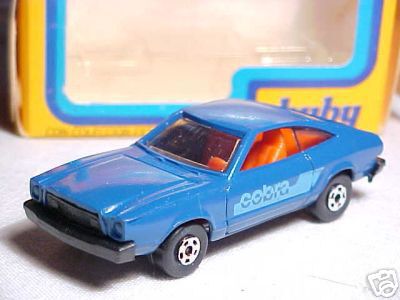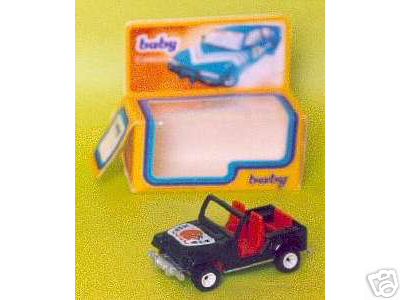 |
 |
 |

|
|
 |
| Volume VII, Number 1 |
Found in the Letterbox |
Hello Doug,
Recently I bought from Buenos Aires a nice guide book about the history of Buby, so I can tell the history of this marque in a brief way. The book is " Buby La Historia en Fotos" by Lucien Brousse.
Buby was founded in 1957 by Haroldo Mahler, by then a young engineering student. As Mahler himself revealed in the prologue of the book, he conceived the idea of making his own diecast models in june 1956, when he was still an student without enough money to afford a Dinky model to made a gift, and he realized that the argentinian producers by then made very awful products. So he thought, Why not doing better ? ( and cheaper, of course)
 The next day , his professor of Machines and Tools in the
engineering faculty at Buenos Aires university introduced Mahler into the
know how of die-casting. After a hard start, when he walked around Buenos
Aires with some models to show to the little toy shops without any result,
he eventually met the manager of one of the most prestigious toy shop in
the city. The succes forced him to interrupt his engineering studies in
Germany. He choosed the name Buby for the company, because it was his childhood
nickname.
The next day , his professor of Machines and Tools in the
engineering faculty at Buenos Aires university introduced Mahler into the
know how of die-casting. After a hard start, when he walked around Buenos
Aires with some models to show to the little toy shops without any result,
he eventually met the manager of one of the most prestigious toy shop in
the city. The succes forced him to interrupt his engineering studies in
Germany. He choosed the name Buby for the company, because it was his childhood
nickname.
The first model issued by Buby was the 1957 Buick Century Wagon (in civil and ambulance versions) in the 1/40 scale,just because he liked too much the model . The first years of the company were marqued by american models, like the Buick, Chevrolet Belair or the '58 Fairlane, and a couple of german models, the Beetle and the '57 Mercedes Benz 300 SL Roadster that Mahler admired in a trip in Germany. Very soon, he started to center his attention in locally produced cars and trucks, as the '57 Ford F100 and Renault Dauphine, as he noted that the chidren, as well as the collectors, would prefer to buy models of the real cars that he saw in the everyday traffic. Another succesful idea was to introduce racing versions as " Turismo Standard" and " Turismo Carretera" (road racing at least in their origin)
As Argentina was still a prosperous country during the sixties, Buby had a succesfull decade. But at the end of the sixties, the cheaper 1/64 models from Matchbox and other competitors were fading the market share for the 1/40 models of the company. In 1968 , the first " Mini Buby" models were released. In the beginning, just were 4 models made in plastic, like the first Siku models, and they are deived from 1/40 catalogue: Chrysler Valiant, '62 Ford Falcon and Fiat 600 and 1500.
Very quickly, these plastic models were replaced by die-cast models, called now " Serie 10 " , being the Valiant the only model that not remained in production. The catalogue followed the same logic that the bigger models, reproducing above all argentinian made or assembled cars. pickups and trucks, reason the way until the end of the series was full of Renault, Peugeot, CitroÎn, Ford and Chevrolet models. Notable exceptions, like Maserati, Mercedes Benz cars (trucks and busses being asembled there since the 50s) or MacLaren F1 mostly existed because used to be part of the moulds of "Prototipos Jet" a product line comissioned to Buby by Gillete de Argentina, and remained after in the product range.
 The serie 10 evolved into the " Serie 100" with
the abandon of some models ( Peugeot 404, Fiat 600 and 1500) and the addition
of the "Serie 200", trucks in the 1/90 scale.
The serie 10 evolved into the " Serie 100" with
the abandon of some models ( Peugeot 404, Fiat 600 and 1500) and the addition
of the "Serie 200", trucks in the 1/90 scale.
The Argentinian political and economic situation was bad in the middle of the 70s. Mahler, who started the production in their own home in Ranelagh and after that build a new factory in CÛrdoba(central zone of the country, belong to the real cars production) closed the production of the 1/40 models in the late seventies, above all because his products faced the hard competition from foreign models.
In 1982, with all the production focused in the 1/64 models and a all new factory in Don Torcuato ( near Buenos Aires) Buby launched the "Serie 1000" , by far the most produced of the all scale Buby series, with a production level of 10000 units/day, 200000 per week by 1986-87. In these years, Buby released some TV-related products like the A-Team set ( Ford Van, Bronco pick up, a buggy and a Maserati Indy) Knight Rider Maserati Indy - what a prestigious change-and a dUKES of Hazzard Ford Mustang II, plus some Ford vans with Coca-Cola, Pepsi, JPS, Marlboro, Peugeot and Carrefour decals.
All these merchandising was not enough to Buby for survive the disastrous hiperinflation in the late 80S. The next decade saw a much more stable economic situation for Argentina, but the drastic reduction of import taxes finally killed the 1/64 series.
Buby tried to survive releasing a cheap 1/43 Renault 19 4 doors model, to fight against asian competition, and retooling some of their most beautiful 1/40 models in a limited collector series. The cheap model failed, but the Collectors series, with a 20000 units per model,500 per variaton production remained until 2000. After this year, you can easily imagine why not are any longer produced.
However, even in despite the fact that Haroldo Mahler have 73 years now, he announced that he would be back in the business this year. As he told in a interview with the argentinian site www.ba-toymuseum.com.ar in march 2003, he pretends to do his comeback in base to the Collector series, with a improved quality and similar production levels as for the late 90s (20000 units per model, for a 6 to 10 models range) It would be good if he can do it again but personally I don't think that a 1/64 model range could be released again, because who can compete against the chinese production?
How much can cost a Buby model? Prices range came from US$10-12 for the late Serie 1000 models to US$60 for a mint plastic or Serie 10 model, and US$30-40 for playworn models. Models like the Renault Torino ( a AMC Rambler American heavily redesigned by Pininfarina) and the Fiat models are by far the most expensive models.
This article is based in the book "Buby, La Historia en Fotos" by Lucien Brousse and an interview of Haroldo Mayer from www.ba-toysmuseum.com.ar from march 2003.
Special thanks to Gabriel Febbraro for the images of this article, and
provide me very kindly the book, all my Buby models and the most that I
know about this hobby.
Rodrigo Toledo
Editor's Response: Thank you Rodrigo for more details about Buby
diecast. As the image of the Mustang II above shows, these were well-done
toy cars. Most are seldom seen in Europe, Asia or North America. Your efforts
to provide a translation are appreciated.
|
HOME>>
|
|